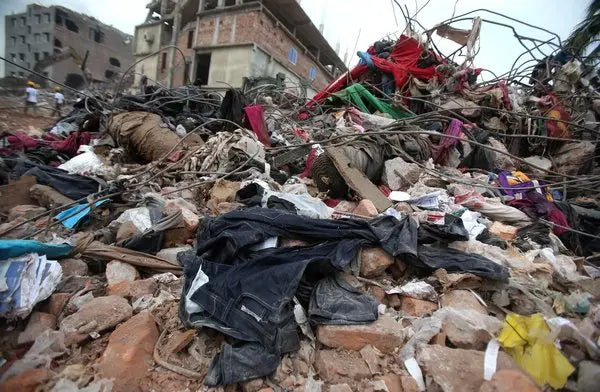
Is fashion ready for the EU’s ban on the destruction of unsold goods? DEBBIE SHAKESPEARE looks at the ramifications of the wide-reaching EU regulations
LONDON – Fashion has always been about firsts. It’s a sentiment that’s even echoed from a regulatory perspective, with textiles the first sector to be regulated under the Ecodesign for Sustainable Products Regulation (ESPR). What’s more, textiles are scheduled to be among the first in line to have mandatory Digital Product Passports (DPPs). Regulation in fashion has never been so on-trend.
The most pressing date for fashion brands and their suppliers was July 18, this year. This was when the ESPR officially entered into force, 20 days after being added to the Official Journal of the EU. From this point, fashion businesses have a 24-month timeline before the EU’s ban on the destruction of unsold (and returned) goods goes live. It is the starting point for a huge amount of strategic planning that needs to happen across the supply chain, both upstream and downstream, for brands selling apparel and footwear into the EU.
The overproduction of textile goods is a serious sustainability issue, which results in needless consumption of resources.
What is the ESPR?
To recap, the EU’s ESPR is expected to apply to all textile products by 2038. The regulation aims to establish a transformative approach to how products are designed, produced, and disposed of in the EU, to tackle their environmental impact, with the aim of boosting circularity within the EU as a lever to achieve net-zero by 2050.
A key element of the ESPR is the Digital Product Passport which will make product-specific and sustainability information accessible via a digitally enabled data carrier such as a QR code or NFC (near field communication) tag.
The ESPR includes a ban on the destruction of unsold textile goods as well as annual reporting of unsold goods. Therefore, brands must support this requirement by making data available relating to textile waste in their supply chain.
While the legal framework for ESPR was officially adopted by EU lawmakers in April 2024 and set in motion this July, the actual requirements for all product groups will only be published in the next stage. It’s expected that a new Ecodesign Forum will be established this autumn to adopt the first Working Plan in March 2025, setting the timeline and product groups that will be addressed in the coming years. Member States are to lay down penalties for non-compliance, including fines.
Small and micro companies will be exempt from the ban on the destruction of unsold textile goods, while medium-sized companies are expected to benefit from a six-year exemption.
For large companies, the clock is ticking. These acts, as part of ESPR, are now gaining real momentum, and action should be taken as a matter of urgency.
Destruction of unsold goods
While the destruction of unsold textile goods is not a customer-facing issue, it will tie into retailers’ need to track obsolete unsold inventory. Digital identification solutions make tracking and reporting easier and a platform hosting all the data, like Avery Dennison’s atma.io connected product cloud, helps to monitor stock and identify improvement opportunities.
These items can be either overstocks (products that are produced but have never been sold), obsolete products (products for which there is no longer any demand), or products that are damaged or recalled by their manufacturer because of quality issues.
To state the obvious, overstock and obsolete products are the result of a mismatch between demand and production. This mismatch can be due to inaccurate forecasting, market dynamics and a conscious business strategy.
We know that textile products are a priority. How can clothing and footwear retailers stop over-producing and destroying unsold goods in readiness for the inevitable ban?
Tighter inventory management
Fashion retailers must begin by mastering more accurate inventory management and demand forecasting. This will require close collaboration with suppliers and investment in the technology needed for advanced demand-tracking analytics. If forecasting can incorporate weather predictions, economic impacts on consumer behaviour, and hyper-localised demand, brands can scale up and down their production, in line with almost real-time needs. This will eliminate waste, which has a direct impact on an organization’s Scope 3 inventory.
It’s likely that product data platforms, forecasting software, RFID tracking and AI will improve demand forecasting accuracy, reducing overproduction. Further, implementation of just-in-time (JIT) manufacturing and inventory management practices will help to minimize excess stock too.
Product lifecycle management
Circular economy practices need to become mainstream. For instance, large-scale take-back programs allow retailers to retrieve unsold or returned items for refurbishment or recycling.
Resale and re-use channels are expected to flourish as brands rush to move on unsold stock rather than destroy it. By professionalising resale markets and educating consumers on the importance of shopping through these channels, a great deal of ‘waste’ stock can be given a second life.
The answer must be for brands to make less in the first place. Brands know only too well that excess stock is a costly pain point with a carbon impact. The hope is that too much inventory becoming a legal weight around their necks will push brand owners into action.
My advice would be to work with suppliers to create more sustainable and less wasteful production processes. It’s also imperative to implement traceability systems to track the lifecycle of products and materials. This will require many conversations and collaborations with suppliers, too.
The adoption of digital twin technology and DPPs to simulate and optimize product lifecycles is also key to complying with the EU’s ban on the destruction of goods. With DPPs playing such an important role in the customer-facing elements of ESPR, it makes sense for brands to leverage them for smarter supply chain management, too. After all, traceability and transparency can tell both a product’s upstream and downstream story.
Achieving compliance is a major business win. By adopting these strategies, fashion retailers can not only meet ESPR requirements but also position themselves as leaders in sustainability, gaining a competitive edge and meeting the growing consumer demand for responsible fashion.
Here are some statistic on how over production and lack of regulations impacts the planet.
The fashion industry is a significant polluter and a driver of environmental degradation. Here's a breakdown of its impact:
Global Pollution Impact
-
Carbon Emissions: The fashion industry is responsible for around 10% of global carbon emissions, more than international flights and maritime shipping combined. This is due to energy-intensive production processes and the long supply chains involved in garment production and distribution.
-
Water Use: The industry consumes an estimated 79 trillion liters of water annually, largely due to cotton farming and dyeing processes. This contributes to water scarcity in regions like Central Asia, where the Aral Sea has nearly dried up due to irrigation for cotton crops.
-
Waste: About 92 million tons of textile waste is generated annually, much of which ends up in landfills or incinerated. Additionally, 35% of all microplastics in the ocean come from synthetic fibers like polyester, which shed during washing.
-
Toxic Chemicals: Toxic dyes and chemicals used in textile manufacturing contaminate water sources, especially in regions where regulations are lax. The fashion industry is responsible for about 20% of global wastewater pollution.
Overproduction by Region
Estimates suggest that about 30-40% of clothing produced worldwide is never sold, contributing to waste and overproduction. This varies by region:
- Asia (notably China, Bangladesh, and India): As the world's largest producer of textiles, Asia accounts for a substantial portion of overproduction, likely over 50% of global excess due to its massive manufacturing capacity. China alone produces over 30% of the world's garments.
- Europe: Known for high-end and fast fashion brands, Europe contributes significantly to overproduction as well, especially through major fashion hubs like Italy, Spain, and the UK. It is estimated that Europe accounts for around 20-25% of global overproduction.
- North America: With its large consumer base, North America (primarily the U.S.) is responsible for around 15-20% of the industry's overproduction, driven by a demand for fast fashion and seasonal trends.
Together, these regions contribute heavily to the environmental impact of the fashion industry through waste, pollution, and inefficient supply chains.
WvG operates as a quasi drop-model company. We've always aimed to stay as lean as possible, producing just enough for our customers. This approach not only makes your WvG pieces more exclusive but also helps keep our planet a little cleaner.
WvG is spreading the word from a story written by Debbie Shakespeare is senior director of sustainability with Avery Dennison.



